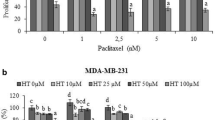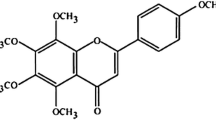Abstract
Purpose
Developing approaches that will increase the selectivity of anticancer drugs remains a challenge. Docosahexaenoic acid (DHA) has the potential to increase tumor sensitivity to chemotherapy with no sensitization of normal tissues. This study was aimed at exploring the mechanism involved in this differential sensitization with a focus on oxidative stress, one of the main determinants involved in DHA enhancement of anthracycline-based chemotherapy.
Methods
In a previously validated model of chemically induced mammary tumors in rats where supplemental DHA sensitized tumors to epirubicin, DHA level, lipid hydroperoxides (LPO), total antioxidant activity, glutathione peroxidase (GPx), and superoxide dismutase (SOD) activities were measured in tumors, intestine, liver, and heart in rats treated with DHA+epirubicin and in control rats (palm oil, no chemotherapy).
Results
At baseline, the level of LPO was similar in tumors, liver, heart, and small intestine. The proportion of DHA was higher in non-tumor tissues compared to tumors (liver or heart, p < 0.0001; intestine, p = 0.01). DHA and epirubicin induced a significant increase in LPO in tumors (p = 0.03), but no increase was detected in liver, heart, or intestine. The difference in LPO production between these tissues was associated with differences in their antioxidant defenses. In tumors, the adjustment of GPx activity was possible but limited, and no adjustment of their total antioxidant and SOD activities was observed compared to other tissues.
Conclusion
Supplementing DHA during an anthracycline-based chemotherapy induced a selective increase of LPO in tumors. This selectivity might result from a differential handling of oxidative stress between tumor and non-tumor tissues.


Similar content being viewed by others
Abbreviations
- DHA:
-
Docosahexaenoic acid
- DTT:
-
Dithiothreitol
- EPA:
-
Eicosapentaenoic acid
- FAME:
-
Fatty acid methyl ester
- GPx:
-
Glutathione peroxidase
- LPO:
-
Lipid hydroperoxides
- NMU:
-
N-Nitroso N-Methyl Urea
- PUFA:
-
Polyunsaturated fatty acid
- ROS:
-
Reactive oxygen species
- SOD:
-
Superoxide dismutase
- TBARS:
-
Thiobarbituric acid-reactive materials
References
Bougnoux P, Hajjaji N, Maheo K, Couet C, Chevalier S (2010) Fatty acids and breast cancer: sensitization to treatments and prevention of metastatic re-growth. Prog Lipid Res 49:76–86
Pardini RS (2006) Nutritional intervention with omega-3 fatty acids enhances tumor response to anti-neoplastic agents. Chem Biol Interact 162(2):89–105
Calviello G, Serini S, Piccioni E, Pessina G (2009) Antineoplastic effects of n-3 polyunsaturated fatty acids in combination with drugs and radiotherapy: preventive and therapeutic strategies. Nutr Cancer 61:287–301
Shaikh IA, Brown I, Wahle KW, Heys SD (2010) Enhancing cytotoxic therapies for breast and prostate cancers with polyunsaturated fatty acids. Nutr Cancer 62(3):284–296
Biondo PD, Brindley DN, Sawyer MB, Field CJ (2008) The potential for treatment with dietary long-chain polyunsaturated n-3 fatty acids during chemotherapy. J Nutr Biochem 19:787–796
Baumgartner M, Sturlan S, Roth E, Wessner B, Bachleitner-Hofmann T (2004) Enhancement of arsenic trioxide-mediated apoptosis using docosahexaenoic acid in arsenic trioxide-resistant solid tumor cells. Int J Cancer 112(4):707–712
Sturlan S, Baumgartner M, Roth E, Bachleitner Hofmann T (2003) Docosahexaenoic acid enhances arsenic trioxide-mediated apoptosis in arsenic trioxide-resistant HL-60 cells. Blood 101:4990–4997
Wirtitsch M, Roth E, Bachleitner-Hofmann T, Wessner B, Sturlan S (2009) Omega-3 and omega-6 polyunsaturated fatty acids enhance arsenic trioxide efficacy in arsenic trioxide resistant leukemic and solid tumor cells. Oncol Res 18(2–3):83–94
Hardman WE, Avula CP, Fernandes G, Cameron IL (2001) Three percent dietary fish oil concentrate increased efficacy of doxorubicin against MDA-MB 231 breast cancer xenografts. Clin Cancer Res 7:2041–2049
Shao Y, Pardini L, Pardini RS (1995) Dietary menhaden oil enhances mitomycin C antitumor activity toward human mammary carcinoma MX-1. Lipids 30:1035–1045
Mahéo K, Vibet S, Steghens JP, Dartigeas C, Lehman M, Bougnoux P, Goré J (2005) Differential sensitization of cancer cells to doxorubicin by DHA: a role for lipoperoxidation. Free Radic Biol Med 39(6):742–751
Germain E, Chajes V, Cognault S, Lhuillery C, Bougnoux P (1998) Enhancement of doxorubicin cytotoxicity by polyunsaturated fatty acids in the human breast tumor cell line MDA-MB-231: relationship to lipid peroxidation. Int J Cancer 75(4):578–583
Lindskog M, Gleissman H, Ponthan F, Castro J, Kogner P, Johnsen JI (2006) Neuroblastoma cell death in response to docosahexaenoic acid: sensitization to chemotherapy and arsenic-induced oxidative stress. Int J Cancer 118(10):2584–2593
Colas S, Germain E, Arab K, Maheo K, Goupille C, Bougnoux P (2005) Alpha-tocopherol suppresses mammary tumor sensitivity to anthracyclines in fish oil-fed rats. Nutr Cancer 51:178–183
Colas S, Mahéo K, Denis F, Goupille C, Hoinard C, Champeroux P, Tranquart F, Bougnoux P (2006) Sensitization by dietary docosahexaenoic acid of rat mammary carcinoma to anthracycline: a role for tumor vascularization. Clin Cancer Res 12(19):5879–5886
Bougnoux P, Hajjaji N, Ferrasson MN, Giraudeau B, Couet C, Le Floch O (2009) Improving outcome of chemotherapy of metastatic breast cancer by docosahexaenoic acid: a phase II trial. Br J Cancer 101:1978–1985
Murphy RA, Mourtzakis M, Chu QS, Baracos VE, Reiman T, Mazurak VC (2011) Supplementation with fish oil increases first-line chemotherapy efficacy in patients with advanced non small cell lung cancer. Cancer 117(16):3774–3780
Hajjaji N, Schubnel V, Bougnoux P (2011) Determinants of DHA incorporation into tumor tissue during dietary DHA supplementation. Lipids 46(11):1063–1069
Atkinson TG, Barker HJ, Meckling-Gill KA (1997) Incorporation of long-chain n-3 fatty acids in tissues and enhanced bone marrow cellularity with docosahexaenoic acid feeding in post-weanling Fischer 344 rats. Lipids 32(3):293–302
Atkinson TG, Murray L, Berry DM, Ruthig DJ, Meckling-Gill KA (1997) DHA feeding provides host protection and prevents fibrosarcomas-induced hyperlipidemia while maintaining the tumor response to araC in Fischer 344 rats. Nutr Cancer 28:225–235
Atkinson TG, Meckling-Gill KA (1995) Regulation of nucleoside drug toxicity by transport inhibitors and omega-3 polyunsaturated fatty acids in normal and transformed rat-2 fibroblasts. Cell Pharmacol 2:259–264
Hardman WE, Moyer MP, Cameron IL (2002) Consumption of an omega-3 fatty acids product, INCELL AAFA, reduced side-effects of CPT-11 (irinotecan) in mice. Br J Cancer 86(6):983–988
Xue H, Sawyer MB, Field CJ, Dieleman LA, Baracos VE (2007) Nutritional modulation of antitumor efficacy and diarrhea toxicity related to irinotecan chemotherapy in rats bearing the ward colon tumor. Clin Cancer Res 13:7146–7154
Germain E, Bonnet P, Aubourg L, Grangeponte MC, Chajès V, Bougnoux P (2003) Anthracycline-induced cardiac toxicity is not increased by dietary omega-3 fatty acids. Pharmacol Res 47(2):111–117
Teng LL, Shao L, Zhao YT, Yu X, Zhang DF, Zhang H (2010) The beneficial effect of n-3 polyunsaturated fatty acids on doxorubicin-induced chronic heart failure in rats. J Int Med Res 38(3):940–948
Olson RD, Mushlin PS (1990) Doxorubicin cardiotoxicity: analysis of prevailing hypotheses. FASEB J 4(13):3076–3086
Doroshow JH (1983) Effect of anthracycline antibiotics on oxygen radical formation in rat heart. Cancer Res 43(2):460–472
McEligot AJ, Yang S, Meyskens FL Jr (2005) Redox regulation by intrinsic species and extrinsic nutrients in normal and cancer cells. Annu Rev Nutr 25:261–295
Buettner GR (1993) The pecking order of free radicals and antioxidants: lipid peroxidation, a-tocopherol, and ascorbate. Arch Biochem Biophys 300:535–543
Imai H, Nakagawa Y (2003) Biological significance of phospholipid hydroperoxide glutathione peroxidase (PHGPx, GPx4) in mammalian cells. Free Radic Biol Med 34:145–169
Fridovich I (1995) Superoxide radical and superoxide dismutases. Annu Rev Biochem 64:97–112
Folch J, Lees M, Sloane Stanley GH (1957) A simple method for the isolation and purification of total lipides from animal tissues. J Biol Chem 226:497–509
Childs CE, Romeu-Nadal M, Burdge GC, Calder PC (2010) The polyunsaturated fatty acid composition of hepatic and plasma lipids differ by both sex and dietary fat intake in rats. J Nutr 140:245–250
Szatrowski TP, Nathan CF (1991) Production of large amounts of hydrogen peroxide by human tumor cells. Cancer Res 51:794–798
Toyokuni S, Okamoto K, Yodoi J, Hiai H (1995) Persistent oxidative stress in cancer. FEBS Lett 358:1–3
Schumacker PT (2006) Reactive oxygen species in cancer cells: live by the sword, die by the sword. Cancer Cell 10:175–176
Oberley TD, Oberley LW (1997) Antioxidant enzyme levels in cancer. Histol Histopathol 12:525–535
Sprecher H (2002) The roles of anabolic and catabolic reactions in the synthesis and recycling of polyunsaturated fatty acids. Prostagland Leukot Essent Fatty Acids 67:79–83
Das UN, Huang YS, Begin ME, Ells G, Horrobin DF (1987) Uptake and distribution of cis-unsaturated fatty acids and their effect on free radical generation in normal and tumour cells in vitro. Free Radic Biol Med 3:9–14
Preuss M, Girnun GD, Darby CJ, Khoo N, Spector AA, Robbins ME (2000) Role of antioxidant enzyme expression in the selective cytotoxic response of glioma cells to gamma-linolenic acid supplementation. Free Radic Biol Med 28(7):1143–1156
Calviello G, Palozza P, Franceschelli P, Bartoli GM (1997) Low-dose eicosapentaenoic or docosahexaenoic acid administration modifies fatty acid composition and does not affect susceptibility to oxidative stress in rat erythrocytes and tissues. Lipids 32(10):1075–1083
Girotti AW (1998) Lipid hydroperoxide generation, turnover, and effector action in biological systems. J Lipid Res 39(8):1529–1542
Moore K, Roberts LJ 2nd (1998) Measurement of lipid peroxidation. Free Radic Res 28(6):659–671
Xia E, Rao G, Van Remmen H, Heydari AR, Richardson A (1995) Activities of antioxidant enzymes in various tissues of male Fischer 344 rats are altered by food restriction. J Nutr 125(2):195–201
Ding WQ, Lind SE (2007) Phospholipid hydroperoxide glutathione peroxidase plays a role in protecting cancer cells from docosahexaenoic acid-induced cytotoxicity. Mol Cancer Ther 6(4):1467–1474
Galeotti T, Borrello S, Minotti G, Masotti L (1986) Membrane alterations in cancer cells: the role of oxy radicals. Ann N Y Acad Sci 488:468–480
Vibet S, Goupille C, Bougnoux P, Steghens JP, Goré J, Mahéo K (2008) Sensitization by docosahexaenoic acid (DHA) of breast cancer cells to anthracyclines through loss of glutathione peroxidase (GPx1) response. Free Radic Biol Med 44:1483–1491
Ding WQ, Vaught JL, Yamauchi H, Lind SE (2004) Differential sensitivity of cancer cells to docosahexaenoic acid-induced cytotoxicity: the potential importance of down-regulation of superoxide dismutase 1 expression. Mol Cancer Ther 3:1109–1117
Acknowledgments
DHASCO was graciously provided by Martek Biosciences (Columbia, MD, USA) and palm oil by the Société Industrielle des Oléagineux (St Laurent Blangy, France). We also thank Valérie Schubnel for her contribution to this work. NH was supported by a grant “Poste d’Accueil” from Inserm.
Conflict of interest
The authors report no conflict of interest.
Author information
Authors and Affiliations
Corresponding author
Rights and permissions
About this article
Cite this article
Hajjaji, N., Besson, P. & Bougnoux, P. Tumor and non-tumor tissues differential oxidative stress response to supplemental DHA and chemotherapy in rats. Cancer Chemother Pharmacol 70, 17–23 (2012). https://doi.org/10.1007/s00280-012-1884-0
Received:
Accepted:
Published:
Issue Date:
DOI: https://doi.org/10.1007/s00280-012-1884-0




